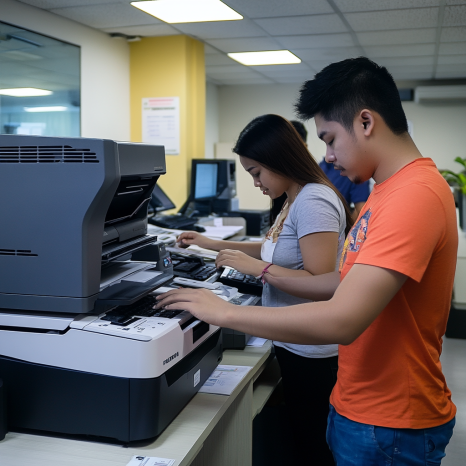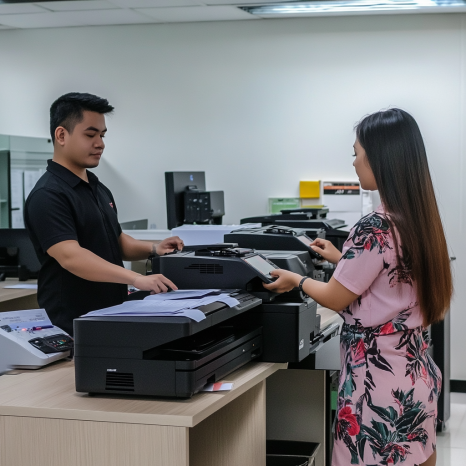
Remote Support for Printer Issues
Part 1: The Growing Importance of Remote Support for Printer Issues
Remote Support for Printer Issues: In today’s fast-paced business environment, maintaining the smooth operation of office equipment is crucial. Printers, in particular, are essential tools in many workplaces, from small businesses to large corporations. However, when printers malfunction, they can disrupt productivity and lead to costly delays. This is where remote support for printer issues comes into play. In this section, we will explore the growing importance of remote support for printer maintenance, troubleshooting, and repair, and how it can benefit businesses of all sizes.
What is Printer Rental?
Printer rental is a convenient service that allows businesses to rent printers for a designated period, whether it’s just a few days or several months. This solution is ideal for event organizers who need access to high-quality printing equipment without committing to a long-term purchase. Whether you require a single unit for a small gathering or multiple printers for a large-scale conference, printer rentals offer the flexibility to adjust your printing capacity according to the specific needs of your event.
To begin your journey with printer rentals, our Introduction to Printer Rentals is a valuable resource for beginners. Understanding these basics will empower you to make informed decisions tailored to your business requirements.
For businesses focused on boosting productivity, the Best Printers for Office Use are designed to enhance operational efficiency and streamline workflow. To manage your budget effectively, check out our comprehensive guide on the Cost of Printer Rentals, where you’ll also find practical cost-saving tips.
When it comes to deciding between leasing and buying, our Printer Rentals vs. Purchasing analysis will help you choose the option that best fits your business objectives. Additionally, to explore the wide array of available options, visit our guide on the Types of Printers for Rent, specifically designed to meet various business demands.
For a thorough understanding of the flexibility and terms offered by our Printer Rental Contracts, visit our website. This information will guide you in selecting the most suitable rental agreement for your business, whether you’re considering Short-term or Long-term Rentals.
Finally, to ensure seamless operations at your event, consider our Printer Maintenance and Support services. Discover the best Printer Rental for Events today and elevate your event experience with reliable, high-quality printing solutions.
What Is Remote Support for Printer Issues?
Remote support for printer issues refers to the ability of technical experts to diagnose, troubleshoot, and sometimes even repair printers from a remote location. This service is typically provided via the internet, where a technician can access the printer’s settings and logs, identify problems, and guide users through the necessary steps to resolve the issue. In many cases, remote support can resolve issues more quickly and efficiently than on-site visits, reducing downtime and keeping your business running smoothly.
The concept of remote support has gained traction as businesses increasingly rely on technology to manage day-to-day operations. With printers being critical components of office infrastructure, having access to timely and effective support is essential. Remote support ensures that businesses can minimize disruptions, maintain productivity, and reduce the costs associated with traditional on-site maintenance and repair services.
The Benefits of Remote Support for Printer Maintenance
Reduced Downtime: One of the most significant benefits of remote support is the ability to minimize downtime. Instead of waiting for a technician to arrive on-site, issues can be addressed almost immediately. This is especially important in high-pressure environments where delays can impact deadlines and customer satisfaction.
Cost Savings: Remote support is often more cost-effective than traditional on-site services. Without the need for travel and the associated expenses, businesses can save money while still receiving high-quality support. Additionally, remote support can often resolve issues without the need for expensive parts or replacements, further reducing costs.
Convenience: Remote support offers unparalleled convenience. Businesses can receive assistance at any time, without the need to schedule and wait for an on-site visit. This flexibility allows issues to be resolved during off-hours or whenever it is most convenient for the business.
Scalability: As businesses grow, so do their printing needs. Remote support can easily scale to accommodate additional printers and users. Whether you have a single printer or a fleet of devices across multiple locations, remote support can provide consistent and reliable service.
Expertise: Remote support services are often provided by highly trained technicians who specialize in printer maintenance and repair. These experts have access to the latest tools and technology, enabling them to diagnose and fix issues more accurately and efficiently than a generalist technician might.
Common Printer Issues Addressed by Remote Support
Remote support can address a wide range of printer issues, from minor inconveniences to more complex problems. Some of the most common issues include:
Paper Jams: A frequent issue that can usually be resolved quickly with remote guidance. Technicians can walk users through clearing the jam and adjusting settings to prevent future occurrences.
Connectivity Problems: Whether it’s a wired or wireless connection, remote support can help troubleshoot and resolve issues that prevent the printer from communicating with other devices on the network.
Print Quality Issues: Problems such as streaks, smudges, or faded prints can often be diagnosed remotely. Technicians can advise on cleaning or adjusting the printer’s settings to restore print quality.
Software and Driver Issues: Remote support can assist with updating or reinstalling printer drivers and software, which are often the cause of printer malfunctions.
Error Codes: Printers often display error codes that can be cryptic and confusing. Remote support can quickly interpret these codes and guide users through the steps needed to resolve the issue.
Integrating Remote Support with Printer Rentals
For businesses that opt for printer rentals instead of purchasing, remote support is often included as part of the rental agreement. This integration provides several advantages:
Ongoing Maintenance: Rental agreements typically include regular maintenance, ensuring that printers remain in good working condition. Remote support can be used to address issues as they arise, minimizing the need for physical maintenance visits.
Cost Predictability: With remote support included in the rental agreement, businesses can better predict their printing costs. There are no unexpected expenses for repairs or service calls, as these are often covered under the rental contract.
Flexibility: Remote support offers the flexibility to adjust the level of service as needed. Whether your business requires basic support or more comprehensive assistance, remote services can be tailored to meet your specific needs.
Up-to-Date Technology: Rental agreements often include technology upgrades, ensuring that businesses have access to the latest printers and features. Remote support can help users take full advantage of these upgrades by providing guidance and troubleshooting as needed.
FAQs
What is remote support for printer issues?
- Remote support for printer issues is a service where technicians can diagnose, troubleshoot, and repair printers from a remote location, using the internet to access the printer’s settings and logs. This service allows for quicker resolution of issues without the need for an on-site visit.
How can remote support reduce downtime for my business?
- Remote support can reduce downtime by providing immediate assistance when printer issues arise. Instead of waiting for a technician to arrive on-site, problems can be addressed as soon as they are reported, allowing your business to maintain productivity.
What are the cost benefits of remote support compared to on-site services?
- Remote support is generally more cost-effective than on-site services because it eliminates travel expenses and can often resolve issues without the need for costly parts or replacements. This can lead to significant savings for businesses.
What types of printer issues can be resolved through remote support?
- Remote support can address a wide range of issues, including paper jams, connectivity problems, print quality issues, software and driver problems, and interpreting error codes. Technicians can guide users through resolving these issues quickly and efficiently.
How does remote support integrate with printer rentals?
- Remote support is often included in printer rental agreements, providing ongoing maintenance and troubleshooting as part of the service. This integration helps businesses manage their printing needs more effectively, with predictable costs and access to expert assistance.

Part 2: Enhancing Printer Maintenance and Troubleshooting with Remote Support
As businesses increasingly rely on remote support to manage their printer issues, it’s essential to understand how this service can enhance printer maintenance and troubleshooting. In this section, we will explore the various ways remote support contributes to more effective printer management, the benefits of integrating it with regular maintenance practices, and how it can improve overall troubleshooting processes.
The Role of Remote Support in Printer Maintenance
Printer maintenance is a critical aspect of ensuring that your devices operate smoothly and efficiently. Regular maintenance can prevent many common printer issues, such as paper jams, print quality problems, and hardware malfunctions. Remote support plays a crucial role in maintaining printers by offering timely and proactive interventions.
Proactive Monitoring and Maintenance: One of the most significant advantages of remote support is the ability to monitor printer performance proactively. Remote monitoring tools can track key performance indicators (KPIs) such as print volume, error rates, and toner levels. This data allows technicians to identify potential issues before they become critical, enabling them to perform maintenance tasks remotely, such as firmware updates, calibration, or cleaning cycles.
Scheduled Maintenance: Regular maintenance is essential for prolonging the life of your printers and ensuring consistent performance. With remote support, scheduled maintenance tasks can be automated or initiated by a technician without the need for on-site visits. This includes tasks like checking and updating printer firmware, optimizing settings, and ensuring that consumables like toner and paper are replenished as needed.
Minimizing Disruptions: By handling maintenance tasks remotely, businesses can minimize disruptions to their operations. Remote support allows technicians to perform necessary maintenance during off-hours or at times that are least disruptive to the business. This flexibility ensures that printers are always in optimal condition without interfering with daily operations.
Cost-Effective Maintenance: Remote maintenance is often more cost-effective than traditional on-site services. Businesses can avoid the costs associated with travel and the time lost during on-site visits. Additionally, remote support can help extend the life of printers by ensuring that they are properly maintained, reducing the need for expensive repairs or replacements.
Improving Troubleshooting with Remote Support
Troubleshooting printer issues can be time-consuming and frustrating, especially when problems arise during critical business hours. Remote support significantly enhances the troubleshooting process, making it faster, more efficient, and less disruptive.
Instant Access to Technical Expertise: One of the primary benefits of remote support is the immediate access to expert technicians. When a printer issue occurs, users can connect with a technician who can begin diagnosing the problem right away. This instant access reduces the time spent waiting for help and allows for quicker resolution of issues.
Accurate Diagnostics: Remote support tools enable technicians to access the printer’s settings, logs, and error codes directly. This access allows them to perform a more accurate diagnosis of the issue, often identifying the root cause faster than traditional methods. Accurate diagnostics lead to quicker and more effective solutions, minimizing downtime.
Guided Troubleshooting: For issues that require user intervention, remote support technicians can guide users through the troubleshooting process. This guidance may involve walking users through specific steps, such as clearing a paper jam, adjusting settings, or replacing consumables. Guided troubleshooting ensures that users can resolve issues confidently and correctly, reducing the likelihood of repeat problems.
Remote Repairs: In some cases, remote support can go beyond diagnostics and actually repair the printer remotely. Technicians can adjust settings, apply software patches, or update firmware to resolve issues without needing to send a technician on-site. This capability is particularly valuable for businesses with multiple locations, as it ensures consistent support across all sites.
Comprehensive Troubleshooting Logs: Remote support sessions often generate detailed logs of the troubleshooting process, including the steps taken and the solutions applied. These logs can be invaluable for future reference, helping businesses track recurring issues, understand patterns, and improve overall printer management.
Integrating Remote Support with Printer Rental Agreements
For businesses that choose to rent printers rather than purchase them outright, remote support is often a key component of the rental agreement. Integrating remote support with printer rentals offers several advantages that enhance the overall value of the rental service.
Comprehensive Service Coverage: Printer rental agreements that include remote support provide comprehensive coverage, ensuring that all aspects of printer maintenance and troubleshooting are handled efficiently. This coverage typically includes routine maintenance, monitoring, and on-demand support, all of which are managed remotely to keep printers in top condition.
Predictable Costs: Remote support as part of a rental agreement helps businesses manage their printing budgets more effectively. With maintenance and troubleshooting services included, businesses can avoid unexpected expenses and better predict their printing costs. This predictability is particularly beneficial for budgeting and financial planning.
Seamless Upgrades: Printer technology evolves rapidly, and businesses need to stay up-to-date to remain competitive. Rental agreements that include remote support often also include provisions for technology upgrades. Remote support ensures that users can quickly adapt to new features and resolve any issues that arise during the transition to new equipment.
Enhanced Flexibility: Remote support enhances the flexibility of printer rentals by allowing businesses to scale their printing services as needed. Whether expanding to new locations or increasing print volume during peak periods, remote support ensures that printers can be adjusted and maintained to meet changing demands.
Legal and Contractual Considerations: When integrating remote support with printer rentals, it’s important to understand the legal considerations and contractual terms involved. Businesses should ensure that the rental contract clearly outlines the scope of remote support services, including response times, coverage limits, and responsibilities. Reviewing the contract thoroughly can help avoid misunderstandings and ensure that businesses receive the full benefit of the remote support services included.
FAQs
How does remote support enhance printer maintenance?
- Remote support enhances printer maintenance by enabling proactive monitoring, scheduled maintenance, and cost-effective servicing. It allows technicians to perform essential maintenance tasks remotely, reducing downtime and ensuring that printers remain in optimal condition.
What are the advantages of remote troubleshooting for printer issues?
- Remote troubleshooting offers instant access to expert technicians, accurate diagnostics, guided troubleshooting, and in some cases, remote repairs. These advantages make the troubleshooting process faster, more efficient, and less disruptive to business operations.
Can remote support help with printer software and firmware updates?
- Yes, remote support can assist with updating printer software and firmware, ensuring that printers operate with the latest features and security patches. Technicians can apply updates remotely, minimizing the need for on-site visits and reducing the risk of compatibility issues.
How does remote support integrate with printer rental agreements?
- Remote support is often included in printer rental agreements, providing comprehensive service coverage, predictable costs, seamless upgrades, and enhanced flexibility. This integration ensures that businesses receive consistent and reliable support as part of their rental package.
What legal considerations should be taken into account when using remote support for printers?
- When using remote support for printers, it’s important to review the rental contract for details on service coverage, response times, and responsibilities. Understanding the legal and contractual terms ensures that businesses receive the full benefit of remote support services and avoid potential disputes.

Part 3: Legal Considerations, Contracts, and Policies for Remote Support of Printer Issues
As businesses increasingly rely on remote support to manage printer issues, understanding the legal considerations, contractual obligations, and policies associated with these services becomes essential. This section will delve into the key legal aspects, the importance of clear contracts, and best practices for creating policies that align with your business’s needs.
Legal Considerations for Remote Support Services
When engaging in remote support services for printer issues, businesses must be aware of several legal considerations to protect their interests and ensure compliance with relevant regulations. These considerations include data security, liability, and service level agreements (SLAs).
Data Security and Privacy: Remote support often involves technicians accessing your printer’s settings, logs, and potentially sensitive information. It’s crucial to ensure that your provider adheres to strict data security protocols. This includes using secure connections, encrypting data, and following industry best practices to protect against unauthorized access. Review your provider’s data privacy policies to ensure they comply with local and international regulations, such as GDPR if applicable.
Liability and Risk Management: In any service agreement, it’s important to clearly define liability. This includes determining who is responsible if something goes wrong during a remote support session, such as data loss, hardware damage, or software corruption. The contract should outline the extent of the provider’s liability and any indemnification clauses that protect your business from unforeseen risks.
Service Level Agreements (SLAs): SLAs are critical components of any remote support agreement. These agreements specify the level of service you can expect, including response times, resolution times, and availability of support. Ensure that the SLA aligns with your business’s operational needs and provides clear recourse if the service provider fails to meet their obligations.
Compliance with Industry Regulations: Depending on your industry, there may be specific regulations governing the use of remote support services. For example, healthcare providers must comply with HIPAA regulations when handling patient data, while financial institutions are subject to stringent data protection laws. Make sure that your remote support provider is aware of and compliant with any industry-specific regulations that apply to your business.
The Importance of Clear Contracts for Remote Support
A well-drafted contract is essential for defining the scope of remote support services and protecting both parties’ interests. Here’s what to consider when crafting or reviewing a contract for remote support services:
Scope of Services: The contract should clearly define the scope of services provided, including what types of support are covered, how issues will be resolved, and the process for escalating complex problems. Make sure the contract includes a detailed description of what is included in the remote support package, such as monitoring, diagnostics, troubleshooting, and repairs.
Terms and Conditions: The terms and conditions section should cover the duration of the contract, payment terms, and any conditions under which the contract can be terminated or renewed. It’s important to ensure that the contract is flexible enough to accommodate changes in your business’s needs, such as scaling up support services as your printer fleet grows.
Response and Resolution Times: Specify the expected response and resolution times in the contract. This includes how quickly a technician will respond to a support request and how long it should take to resolve common issues. These times should be realistic and aligned with your business’s operational requirements.
Amendments and Addendums: Over time, your business’s needs may change, requiring adjustments to the original contract. Include clauses that allow for amendments and addendums to the contract, specifying the process for making changes and any associated costs. This flexibility ensures that the contract remains relevant as your business evolves.
Confidentiality Agreements: Given that remote support may involve access to sensitive information, it’s important to include confidentiality agreements in the contract. These agreements protect your business by ensuring that the provider does not disclose or misuse any information accessed during the support process.
Dispute Resolution: Finally, the contract should outline the process for resolving any disputes that may arise between you and the service provider. This might include arbitration, mediation, or legal action. Having a clear dispute resolution process in place helps prevent conflicts from escalating and ensures that issues are resolved fairly and efficiently.
Developing Policies for Remote Support Services
In addition to having a clear contract, businesses should establish internal policies for managing remote support services. These policies help ensure consistency, compliance, and efficiency in how remote support is used within the organization.
Access Control Policies: Establish who within your organization is authorized to request and oversee remote support services. Limiting access to authorized personnel helps maintain control over the support process and ensures that only qualified individuals are involved in managing printer issues.
Data Handling Procedures: Develop procedures for handling data during remote support sessions. This includes ensuring that sensitive data is not exposed during the support process and that all data exchanges are conducted over secure channels. Educate your staff on the importance of data protection and the steps they need to take to safeguard information during remote support interactions.
Documentation and Record-Keeping: Implement a policy for documenting remote support sessions, including the issues addressed, the steps taken to resolve them, and the outcome. Maintaining detailed records helps track the effectiveness of the support provided, identify recurring issues, and improve future support interactions.
Regular Reviews and Audits: Periodically review and audit the effectiveness of remote support services. This can involve assessing the performance of the service provider, evaluating compliance with contractual terms, and ensuring that internal policies are being followed. Regular reviews help identify areas for improvement and ensure that your business continues to receive high-quality support.
Training and Awareness: Provide ongoing training to your staff on how to effectively use remote support services. This includes understanding when to request support, how to interact with technicians, and how to follow internal policies for data protection and documentation. Training helps ensure that your staff is equipped to manage printer issues efficiently and effectively.
Expanded FAQs
What legal considerations should be taken into account when using remote support for printers?
- Legal considerations include ensuring data security and privacy, defining liability and risk management, and establishing clear Service Level Agreements (SLAs). It’s also important to ensure compliance with any industry-specific regulations that apply to your business.
Why are SLAs important in remote support contracts?
- SLAs (Service Level Agreements) are important because they define the expected level of service, including response and resolution times. They provide clear expectations for both parties and offer recourse if the service provider fails to meet their obligations.
What should be included in a remote support contract?
- A remote support contract should include the scope of services, terms and conditions, response and resolution times, provisions for amendments, confidentiality agreements, and a dispute resolution process. These elements ensure that both parties understand their responsibilities and can work together effectively.
How can businesses protect data during remote support sessions?
- Businesses can protect data during remote support sessions by implementing access control policies, using secure data handling procedures, and educating staff on data protection practices. Ensuring that all data exchanges are conducted over secure channels is also crucial.
What internal policies should be developed for managing remote support services?
- Internal policies for managing remote support services should include access control, data handling procedures, documentation and record-keeping, regular reviews and audits, and staff training. These policies help ensure consistency, compliance, and efficiency in how remote support is used within the organization.

To learn more about sustainable copier rental solutions and how Marga Enterprises can support your green initiatives, contact us today at 09171642540 or 09614481276. You can also reach us via email at marga.enterprises2013@gmail.com. Let’s work together to build a greener, more sustainable future for generations to come. Visit Marga Enterprises and find out why we are the No. 1 Copier & Printer Rental Provider in the Philippines.
Join our growing community on Facebook and Youtube for exclusive content and discussions designed to propel your business forward. Follow our posts and be part of the conversation!
